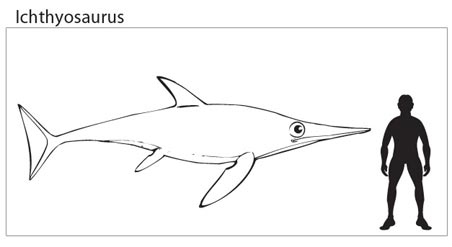Ichthyosaurs and their Young – Mesozoic Marine Reptiles
Ichthyosaurs, otherwise known as “fish lizards” are group of marine reptiles, that have their origins in the Triassic Period. These sea monsters evolved into a variety of forms and adapted to a number of different types of marine habitats and diets. Although, widely regarded by scientists as being the most highly adapted reptiles in the Mesozoic seas, these creatures began to become rarer and rarer towards the end of the Cretaceous, and it is believed that they died out before the mass extinction event that led to the demise of the dinosaurs and other types of marine reptile.
Ichthyosaurs
Looking like a modern dolphin, ichthyosaurs were powerful swimmers, some of the more streamlined specimens, smaller animals such as Ophthalmosaurus were perhaps capable of swimming at speeds of more than 40 kph.
A Scale Drawing of an Ichthyosaurus

Picture credit: Everything Dinosaur
To read an article about a recent ichthyosaur fossil discovery: Getting Ahead with an Ichthyosaurus.
Many Different Species
Many different species of ichthyosaur are now known. As a group, they were perhaps the best adapted to a life in the water of all the marine reptiles. Fossils of Jurassic ichthyosaurs discovered in limestone quarries in Germany (Holzmaden) preserve these animals in exquisite detail. Some ichthyosaur fossils are so well preserved that the outline of their body shape can still be made out (this is how scientists discovered that ichthyosaurs had a tail fluke). Fossilised stomach contents that have been analysed indicate that different types of ichthyosaurs ate different types of food, with many of them hunting ammonites and their cephalopod relatives the belemnites. Fossils of tiny embryos (unborn ichthyosaur young) can be seen inside the bodies of some of the preserved ichthyosaur specimens. This means that ichthyosaurs did not lay eggs like most other reptiles, but instead gave birth to live young – what scientists refer to as viviparous behaviour.
The ancestors of the ichthyosaurs probably ventured out onto land to lay eggs, just like turtles do today. However, over many thousands of generations, these creatures became completely adapted to a marine existence and with their highly modified flippers these animals could no longer move around on land. Most ichthyosaurs would give birth to one or two single babies (often called pups), although one fossil of an ichthyosaur shows eleven embryos preserved inside the body chamber. It seems that babies were born tail first.
As ichthyosaurs gave birth to fully developed young, there has been much speculation as to how ichthyosaurs behaved. It has been suggested for example, that, just like modern whales, pregnant ichthyosaurs congregated together in special areas to give birth. Perhaps, they chose an isolated, sheltered lagoon to give birth. The calm waters would have helped the youngsters and being close to shore there may have been fewer marine predators and plenty of places for young animals to hide such as reefs and in amongst rocks.
A Scale Drawing of the Viviparous Temnodontosaurus
Picture credit: Everything Dinosaur
Famous Fossils
Famous fossils from the Late Jurassic strata reveal that these marine reptiles were viviparous. A female ichthyosaur died in the process of giving birth and her carcase was preserved, becoming one of the most famous fossils of all. The fossilised remains of young ichthyosaurs can be seen in the body cavity, with another baby preserved as a fossil at the moment of birth.
In some species of ichthyosaur, the young have teeth, whereas the adults have no teeth in their snouts. This suggests that baby ichthyosaurs may have had a different diet when compared to the adults. Perhaps the young, agile ichthyosaur babies specialised in catching fish in shallower waters, before migrating to deeper waters to join the adults feeding many on cephalopods and jelly fish.
To view a variety of ichthyosaur and other marine reptile figures: CollectA Age of Dinosaurs Prehistoric Life Models.







Leave A Comment